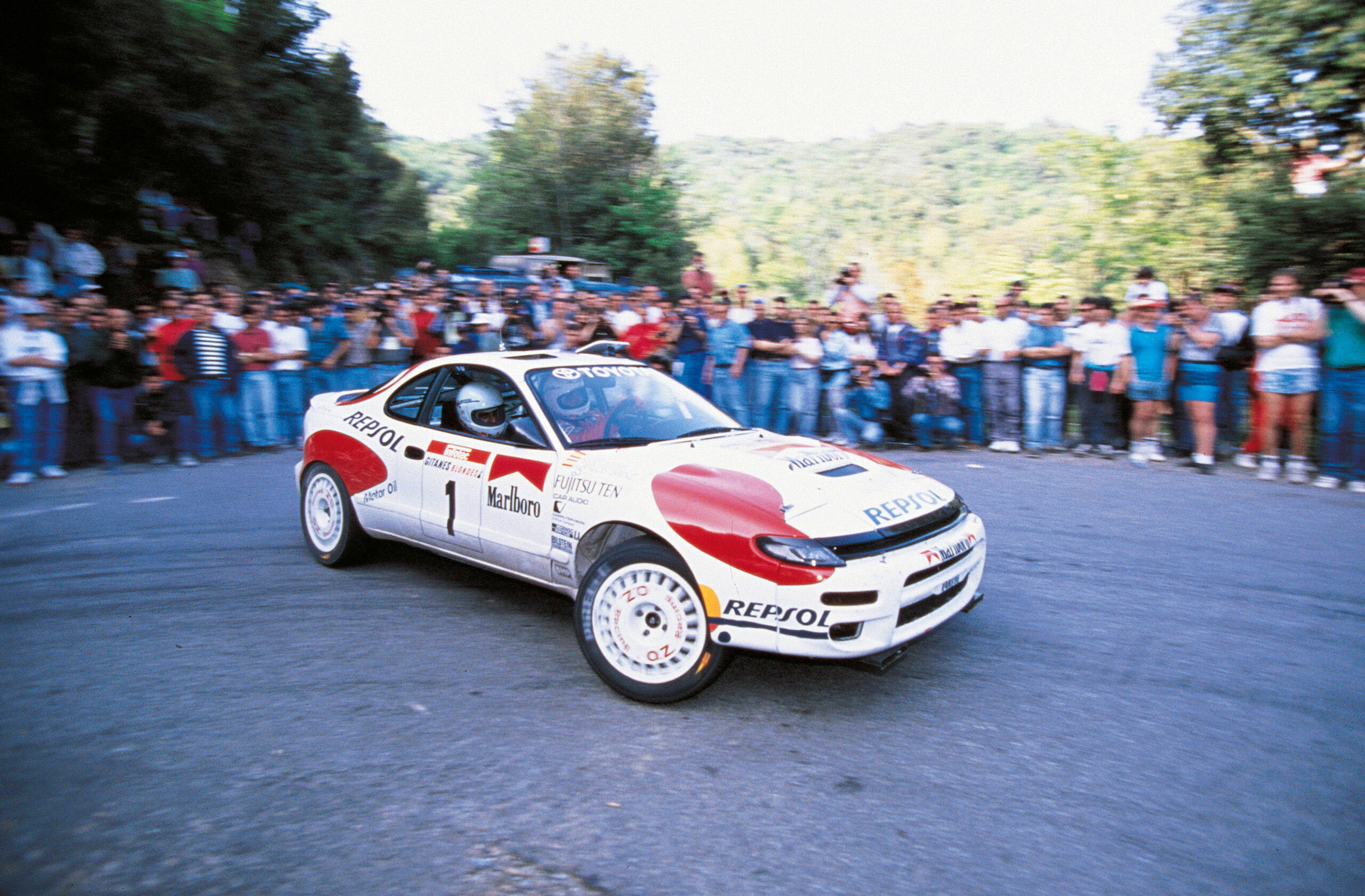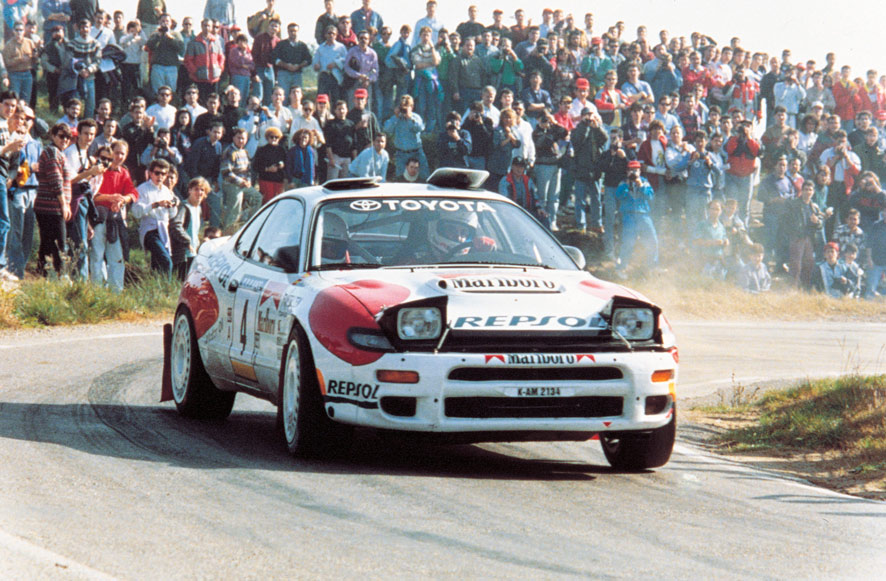1991, the Year when Carlos Sainz Came So Close to Winning the Champion…
9 months ago
For the 1992 World Championship, Toyota unveiled the latest version of their already highly effective rally war horse, the Celica Turbo 4WD ST-185. This version, which was also put on the market as a Carlos Sainz limited edition, of which five thousand units were produced, had new more aerodynamic bodywork, redesigned aluminium suspension, a reinforced chassis, improved cooling system by way of a new front end and the characteristic bonnet air intake, new differential transmission, and improved turbo and intercooler.
The competition hadn’t been complacent either, Lancia was preparing to do battle with its own latest version of the Lancia Delta HF Integrale 16V and Ford with its Sierra RS Cosworth 4×4.
This year the team participated in 11 of the 14 World Championship events but the drivers could only participate in 10 of the scored events. The composition of the team was uneven again, as in previous years, there was occasionally a third car. Carlos Sainz and Luis Moya were the main pairing and would be accompanied in some races during the year by Armin Schwarz with Arne Hertz, Markku Alén with Ilkka Kivimäki, and the already veteran Mikael Ericsson with Nicky Grist.


As is tradition, Montecarlo opened the year. Sainz, Alen, and Schwarz took to the track. The fist stages’ icy tracks delighted fans, but turned driving into dancing on ice. Under these conditions Schwarz was placed first at the beginning of the rally, being later replaced by Sainz. When the tracks began to dry the Lancia re-emerged and the new Celica turned out to be more problematic than expected. Alen suffered an accident that forced him to retire in the fourth stage and Schwarz also suffered a mishap that ruled out any chances of winning, eventually finishing 18th. Sainz managed to finish second more than two minutes behind Didier Aurio’s immovable Lancia.
The Portugal rally didn’t go according to plan either. Despite tweaking the Celica’s set-up, it was difficult to push the car to its limits. While the previous year Sainz dominated on all terrains, in 1992 things went awry, so much so that he had to resort to a more defensive driving style in order to secure points. Kankkunen’s Lancia and Biasion’s Ford were strong and Sainz had to settle for third position, having managed to win only four stages and without leading at any point, just ahead of his teammate Markku Alén. Armin suffered an accident just two stages from the end and had to retire.
Things didn’t look good for the title, but there was still a lot of tarmac, dirt, and gravel to go. We arrived in Kenya where the Safari Rally was staged. This very special race always saw vehicles specially prepared for its hard conditions, combining components of the previous year’s car with the new model. The combination proved to be a success under the harsh conditions of the African tracks, with Sainz finally achieving his first win of the year, more than 50 minutes behind Juha Kankkunen’s Lancia. In addition, Ericsson and Alén finished fourth and fifth respectively.





The World Championship returned to Europe with the Tour de Corse. Corsica’s tracks had seen the Sainz-Toyota duo shine in previous editions, but this time, the new Celica’s aggressive chassis set-up, excessively rigid, and the complicated set-up of the suspension caused excessive tire wear, which worsened with the unexpected high temperatures. With stages of usually more than 20 kilometres, the tires barely lasted half way and Sainz had to drive defensively again, trying to lose as few points as possible. He finished fourth, followed by his team mate Schwarz, while the Frenchman Auriol took another victory with the Lancia.
From Corsica to the Acropolis Rally in Greece, where the team also had success. Sainz, determined to solve the new car’s problems, tried to use geometries and adjustments from the previous year, but being a different system, the results remained the same. Didier Auriol’s Lancia looked unbeatable, leading the overall ranking stage after stage and the time difference grew wider and wider. Sainz only achieved victory in two of the 40 timed stretches. Finally, both he, Alén, and Schwarz suffered accidents, with the team finishing with zero points.





After the poor results of the previous race, but still with a chance of winning the drivers’ championship, Carlos Sainz was set off alone to compete in the New Zealand Rally he had already won the previous two years. The Spanish driver continued to look into how to solve the car’s erratic behaviour, and without the presence of the official Lancias putting the pressure on could bring hope to achieving a coveted second title. Carlos won by four and a half minutes, having led unrivalled since stage 14, taking his third consecutive victory at this rally.
Motivated after his previous victory, Sainz again travelled half way round the world to take part in the Argentina Rally. Lancia and Didier Auriol attended the event to defend themselves from another possible victory against by their opponents. Carlos led the rally at the beginning but little by little he lost ground to his rival. By the end of the last day Sainz had achieved victory in 10 stages to the Frenchman’s 15, who had not given up first place since mid-day of the first day. Carlos then finished in second place, which tasted like victory but all but ended the possibility of a new title.
Carlos, with seven participations already this year, decided not to take on the 1000 lakes and kept the remaining three for less risky races. Markku Alén took his in the Finnish rally to try and stop Auriol or Kankkunen, but only achieved third position behind them.





With the Australia Rally looming, Sainz had 92 points to Auriol’s 100, and the Frenchman had already won five races and Kankkunen, with 77 points, still had races left that could bring him dangerously close to the title. This is why Carlos and Luis gave their all on the dusty tracks of Australia. Even so, it was not enough, the Lancias were again immovable and the Toyota was still too erratic. Sainz could only win seven stages. Didier Auriol won his sixth stage and Kankkunen was second.
With only two more races for Sainz, he decided to forego the Sanremo Rally. But the tables turned, and just like the previous year when the Spaniard’s luck ran out, this time it was Auriol who saw hopes dashed. Already in the first stage, the French Lancia lost a wheel and suffered an accident that forced him out of the rally. Of course, Juha Kankkunen achieved second position that left him second in the World Championship with 107 points. Auriol had 120 and Sainz had 104. The title was still possible.





Carlos Sainz, making good use of his experience and determination, finally managed to solve his Toyota Celica’s adjustment problems. In the Costa Brava Rally, the new set-up, with progressive suspension, turned out to be the key with the car behaving like never before on his home soil. Sainz won at home, making up for the disappointment of retiring the previous year. Meanwhile his two rivals were having mixed fortunes. Kankkunen was second and Auriol spectacularly flew off the track wasting precious time, just finishing tenth and gaining one point. Schwarz who had won the previous year finished in fifth.
Everything would be decided once again at the RAC Rally in England. The weather was bad throughout the race, but that did not discourage Sainz, who came first with 124 points after that motivating victory in his homeland. Kankkunen came second with 122 and Auriol third with 121 points. It was clear, whoever won the race would win the World Championship. Carlos’ Celica Turbo 4WD flew down the British tracks and gave its competitors no chance. With the new adjustments working as he hoped, he maintained the lead for more than three quarters of the rally, to win out right more than two minutes in front of second place. The Spaniard’s rivals got all the bad luck he seemed to have had before. Juha Kankkunen came off the track and finished third while Didier Auriol had engine failure due to a rare problem with the spark plugs.
With his victory in the RAC Rally, Sainz was proclaimed two-time World Rally Champion. He did it with a car that carried his name and not without a hard fight until the very end. Unfortunately, this would be his last year with the Japanese brand. In 1993 Carlos and Luis would defend their crown in another vehicle, yes, you guessed it, with the support of Repsol.
1993, Carlos Sainz’s debut with a Lancia
7 days ago


 Join Us
Join Us  Join Us
Join Us 

